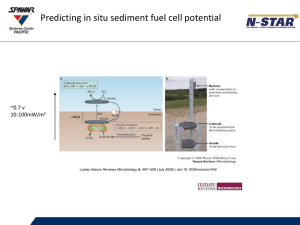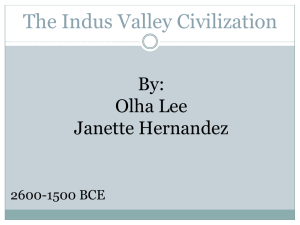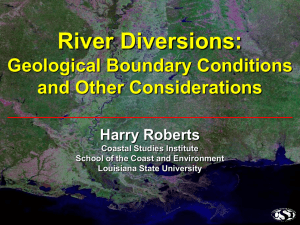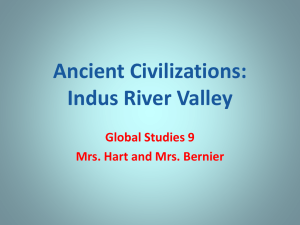Clift-chapman-oral-2011
advertisement
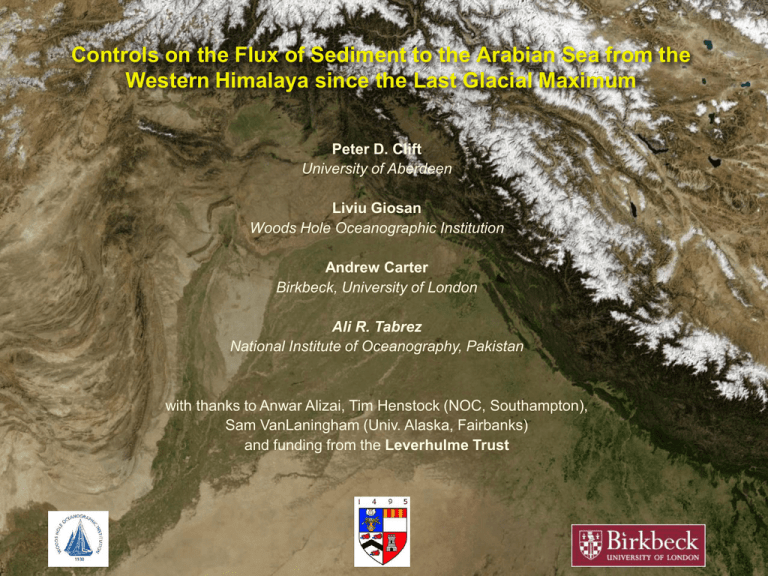
Controls on the Flux of Sediment to the Arabian Sea from the Western Himalaya since the Last Glacial Maximum Peter D. Clift University of Aberdeen Liviu Giosan Woods Hole Oceanographic Institution Andrew Carter Birkbeck, University of London Ali R. Tabrez National Institute of Oceanography, Pakistan with thanks to Anwar Alizai, Tim Henstock (NOC, Southampton), Sam VanLaningham (Univ. Alaska, Fairbanks) and funding from the Leverhulme Trust Research Objectives • Can we use the deep sea marine record to reconstruct past landscape and erosion onshore? • Determine speed of sediment flux from source to sink. • Quantify degree of sediment buffering and reworking in the flood plains. • Estimate degree of storage on the continental shelf To what extent can the deep-sea record be used to reconstruct erosion and landscape evolution in the mountains? Rainfall varies along and across strike within the Indus River system: Competing effects of snow melt and monsoon rains Indus system benefits from a well defined monsoon-climate history since the LGM - How fast does the landscape respond? How does the source of the sediment change? Nd isotopes in sediment make powerful source discriminants in the Western Himalaya and Karakoram Known ranges of zircon U-Pb ages in the sources (DeCelles et al., 2004) This is a powerful provenance tool Evolution in Nd and Sr isotope composition since the Last Glacial Maximum Strong change to more Himalayan erosion, less from Karakoram U-Pb dating of zircon (Laser ICP-MS) Since the LGM the proportion of Lesser Himalayan zircons (~1800 Ma) has greatly increased, while relative flux from Kohistan/Transhimalaya has decreased The timing of zircon population change is different from the Nd isotope shift - suggests a lag in the zircon transport of 5-10 ka Clift et al. (2010) Shifting zircon age populations show marked differences in sediment sources since the LGM, likely driven by climatic variations Early Holocene is characterized by intensified erosion where monsoon rains are strongest Thiede et al. (2003) Bookhagen & Burbank (2005) How much sediment is stored and released in the flood plains? Dating reveals major changes in the patterns of sedimentation since 8 ka Islamabad 6000-4000 yr BP Karachi Present-3000 yr Incision of upper river channels is apparent in the topography Reworking, explains lack of provenance response to monsoon weakening Can zircon be used to reconstruct changes in drainage patterns? Need to fingerprint possible contributions Measured zircon age populations for modern Indus zircons. Each river has its own unique signature Simplified age spectra for the different parts of the modern Indus Note young grains are unique to Indus, Jhelum and Thar Desert So what do we predict the net flux to the delta to be like, assuming water discharge is proportional to sediment load? The sediment at the delta seems to have far too much material from sources typical of the Sutlej and not enough from the Chenab or trunk Indus compared to modern discharge We suggest that this mis-match reflects long transit times for zircons in the river, i.e., delta reflects past sediment flux Measurements of the zircon age spectrum near delta suggest a very different mixture than that indicated by water discharge. The delta sands were not generated by system like the modern river. Can we use the thermochronologic data to reconstruct old drainage patterns? Sampling of sand focused in the region of the archaeological sites of the Indus Valley Civilization How do the Holocene sands compare to their nearest modern stream? - Lots of differences The sands at Tilwalla have a strong 400-500 Ma population similar to the Beas, now a Sutlej tributary The Marot borehole shows strong similarities with the Sutlej and the Yamuna Marot sands show best match with the Yamuna not the Sutlej, but are likely >10 ka Possible drainage evolution model How much sediment is stored in the delta on its way to the deep sea? To what extent is sediment stored on the shelf? Large clinoforms suggest that it could be great Investigated by a cruise in 2008-2009 Giosan et al. (2006) Clinoform on east side of the Indus Canyon Mostly relict and eroded rather than active Indus-7 Indus-8 Indus-6 Indus-5 Indus-3 and -4 Clinoform on west side of the Indus Canyon Newly building and active, but modest volumes New coring suggests that much of the Indus sediment load is reaching the upper canyon but not yet the abyssal plain Conclusions • Erosion in the Indus basin appears to react quickly to • • • • • changes in climate. Strong monsoon causes faster erosion of Lesser Himalaya - Not glacial sediment Nd isotopes, dominated by clays, show rapid response. Zircons lag by 5-10 ka. Reworking of flood plains since Mid Holocene can account for ~80% of the recent sediment flux. Modest storage on the shelf in clinoforms but recent rapid sedimentation in canyon. Lag between erosion in Himalaya and sedimentation in the Indus submarine fan ~10 ka. Read more about this and related science in the new Geological Society Special Publication





